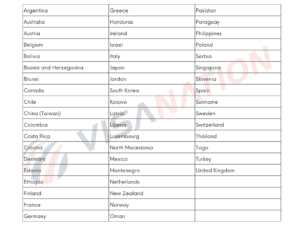The Brewing Disaster at the Northern Border, and Why It Matters
I appeared as a witness at a congressional hearing last week on “Biden’s Growing Border Crisis: Death, Drugs, and Disorder on the Northern Border”. The key takeaway is that there is a brewing disaster at the U.S.-Canada line, but largely missed is why it matters and what lessons in border security President Biden could learn from his Canadian counterpart, Prime Minister Justin Trudeau.
The Northern Border in Context. The Northern border is massive — at 5,525 miles, it’s nearly three times the length of the Southwest border (1,954 miles). As at the U.S.-Mexico line, protecting our international boundary with Canada is the responsibility of the Border Patrol, but the comparative staffing between the two borders is hardly equivalent.
As of the end of FY 2020 — the last year for which published statistics are available — there were nearly 17,000 Border Patrol agents at the Southwest border, but just over 2,000 at its Northern counterpart, a more than 8-to-1 ratio.
That said, there has long been a question of how much protection the Northern border demands. The Secure Fence Act of 2006 called for a study on the need for more infrastructure there, but I’m not sure it was ever completed. That said, the USA PATRIOT Act authorized a tripling of the Border Patrol cadre at Northern Border (there were 340 agents there in FY 2001), while staffing has increased more than six-fold in the interim.
It’s long been referred to as ”the world’s longest undefended border”, and it more or less remains just that — largely undefended by either side.
Illegal Migration at the Northern Border. Of course, from a purely immigration-enforcement standpoint, the United States does not face the sorts of illegal migration pressures at the Northern border that it does at the Southwest border, largely due to the fact that: (1) not many Canadian nationals are seeking to enter this country illegally; and (2) Canada’s unique geography.
As the Council on Foreign Relations recently explained:
Canada’s geography — bordered by three oceans and the United States, which is itself a magnet for immigrants — has helped Ottawa limit flows of undocumented people. Its highly regulated immigration system, including some of the world’s strictest visitor-visa requirements, is designed to further curb this phenomenon.
That’s not to say, however, that Canada has not been a jumping-off point for third-country nationals headed to the United States illicitly, because it has.
As my colleague Todd Bensman has explained in depth, Canada ended visa-free travel from Mexico in 2009, but resumed that program in late 2016.
That has brought not only some very unsavory characters to our neighbor to the north (“Mexican cartel operatives — ‘drug smugglers, human smugglers, recruiters, money launders and foot soldiers’”), but also an increasing number of Mexican nationals transiting Canada to enter the United States illegally.
In FY 2020, Border Patrol agents at the Northern border apprehended 2,155 Mexican nationals entering illegally, a number that dipped to 916 in FY 2021 (when Canada was, in its terms, enforcing “some of the strictest travel and border measures in the world” in response to Covid-19), before jumping again above 2,200 in FY 2022.
Mexican apprehensions at the Northern border have continued to climb, and there were more than 2,800 of them in the first five months of FY 2023.
Nearly 1,200 of the Mexican nationals caught entering the United States over the Northern border thus far in FY 2023 have been caught in the Border Patrol’s Swanton Sector, which has jurisdiction over 295 miles of the line. Again, geography is likely playing a role in the large number of Mexican apprehensions there, as the sector sits less than 50 miles from Montreal and its international airport.
It’s not just Mexican nationals who are entering the United States illegally over the Northern border, however. In FY 2023, 292 Indian nationals have been nabbed entering illegally from Canada, 104 at Swanton Sector alone. Recent reports suggest that those apprehensions are likely just a fraction of the number of Indian nationals coming illegally through Canada.
In a tragic January 2022 incident, Canadian authorities near the border in Manitoba found the bodies of four Indian nationals, a husband and wife and their two children, who had frozen to death attempting to cross illegally into the United States.
The family had come from Dingucha, a village in the Indian state of Gujarat, and entered Canada on visitor visas at Toronto more than a week prior to their deaths. From there, they traveled west, to Manitoba, arriving in the border town of Emerson. An alleged smuggler drove the four and others near the boundary to walk to the United States, but the family became separated and lost.
That incident led to an Indian government investigation of a smuggling ring running nationals of that country through Canada to the United States. As the Times of India reports: “Dingucha village has several agents who facilitate the illegal journey to the US.” There are hundreds of thousands of such villages in India, raising the question of how many other nationals of that country successfully made the trek without being apprehended.
In any event, Border Patrol agents at the Northern border are on pace to make 6,850 apprehensions this fiscal year, a figure that is likely an underestimate given that the 628 Border Patrol apprehensions there in February are the highest monthly total in the last four fiscal years, more than four times higher than last February (122), but more importantly, nearly twice as high as February 2020 (256), the last month before the Covid-19 pandemic was declared.
Illegal Migration to Canada and the Amendment to the Safe Third Country Agreement. As bad as things are for U.S. northern border agents, their counterparts on the Canadian side have had it much worse.
Last year, Canadian authorities stopped nearly 40,000 illegal migrants at the “unofficial” Roxham Road border crossing in Quebec, south of Montreal. Most were likely aliens apprehended and released by Biden’s DHS at the Southwest border, drawn by the benefits (“social assistance, education, health services, emergency housing and legal aid”) Canada offers “asylum seekers”.
Canada might offer generous benefits to those seeking protection in the country, but even immigrant advocates know the Canadian asylum system has its limits. As The Guardian recently reported, in connection with the migrant surge there:
“Asylum seekers on our borders is not something that Canada typically deals with,” said Abdulla Daoud, executive director of the Refugee Centre in Montreal. “This is in many ways a new issue. And while there’s been an uptick, there’s no denying that, we’ve seen that Canada’s immigration infrastructure can handle an increase in population — but the asylum system wasn’t ever built to accommodate this sort of issue.”
Unlike his American counterpart, Prime Minister Trudeau has taken swift action to deal with his migrant surge, as I explained at last week’s hearing. Specifically, he forced the Biden administration to expand the scope of the “Canada-U.S. Safe Third Country Agreement” (STCA), which has been in effect since December 2004.
As originally agreed to, and subject to exceptions, the STCA bars asylum claims by third-country aliens arriving at Canadian ports of entry from the United States, unless the alien already sought and was denied asylum in the United States (and vice-versa).
Under an agreement between Trudeau and Biden during their recent summit in Ottawa, however, the STCA now bars asylum claims by aliens who cross illegally, too. Given that asylum seekers entering Canada from the United States far outnumber those headed in the other direction, this agreement offers little benefit to this country, but is a huge improvement for Canada.
This underscores the fact that the Biden administration treats the U.S. asylum backlog (nearly 1.6 million cases and climbing fast) the way that it treats the deficit — a problem for some future president when it all breaks down.
That said, the amended STCA could be a model for U.S. negotiations on such an agreement with Mexico, a prospect DHS Secretary Alejandro Mayorkas teased at a March 28 Senate hearing. A U.S.-Mexico STCA would benefit both countries, as it would slash illegal U.S. entries and significantly reduce the number of third-country migrants traversing Mexico illegally, and the crime and corruption their smugglers breed.
National Security. As history has shown — repeatedly — not all migrants are innocents seeking a “better life”. Some have terrorist and other malign intentions.
At least two third-country nationals entered the United States illicitly from Canada with such intentions: Gazi Ibrahim Abu Mezer, a Palestinian national and Canadian T-1 (student) visa holder and asylum applicant who entered this country illegally in January 1997; and Ahmed Ressam, an Algerian national who first entered Canada (where he also sought asylum) in 1994 on a photo-substituted passport, and who attempted to enter the United States illegally on a fraudulent Canadian passport — which he had previously used to reenter Canada — in December 1999.
Mezer was arrested by the NYPD in July 1997 while plotting to plant bombs in the New York subway system, while Ressam was stopped by U.S. Customs officers during inspection at Port Angeles, Wash., carrying ingredients to make a bomb he planned to explode at Los Angeles International Airport on or near the turn of the millennium on January 1, 2000.
Ressam’s arrest, in particular, spurred fears that other aliens in Canada were plotting to attack the United States. As the Seattle Times noted in 2002: “The ease with which Ressam re-entered Canada after attending terror-training camp illustrates why U.S. counterterrorism officials sometimes deride their neighbor to the north as ‘the aircraft carrier’ — meaning terrorists can land and take off from there with impunity.”
Canada has significantly beefed-up security in the past two decades, and now faces threats from the south. One such notable threat was Abdulahi Hasan Sharif, a Somali national who presented himself at the U.S. San Ysidro (Calif.) port of entry in 2011, was ordered removed but released, and then entered Canada in 2012 at the Fort Erie, Ont. port of entry, where he was later granted asylum.
Sharif moved to Edmonton and in September 2017 hit a local cop with his car (whom he then stabbed), only to escape and later (on the same day) run down a group of pedestrians with a rental van. Investigators found an ISIS flag in his car, and he has since been sentenced to 28 years in prison.
The Biden administration’s release of millions of illegal migrants at the Southwest border poses a significant (and unacceptable) national-security risk to the United States. And, given the lack of any effective impediment to illegal entry from this country into Canada, a threat to that nation, as well.
“Sleeping With an Elephant”. As the current prime minister’s father, then-Prime Minister Pierre Trudeau, told President Nixon in 1969: “Living next to you is in some ways like sleeping with an elephant. No matter how friendly and even-tempered is the beast, if I can call it that, one is affected by every twitch and grunt”.
Under Nixon’s latest successor, the main “twitches and grunts” emanating from Canada’s elephantine neighbor are the products of the president’s feckless and mercurial border policies, which not only come with a fiscal and national-security cost to the United States, but to our ally to the north, as well. If Joe Biden won’t enforce his southern border, Justin Trudeau will enforce his. I never thought I would say this, but the president may want to take a lesson from Trudeau fils.





